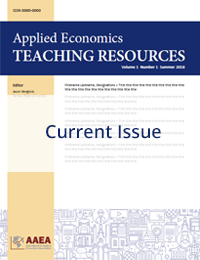Volume 3, Issue 1, March 2021Download PDF
Research Articles
Course-Related Student Anxiety During COVID-19: A Problem and Some Solutions
Roger Brown, Steve Buck, Michelle Kibler, Jerrod Penn, and Na Zuo
Download PDF
First Published Online: April 18, 2021
DOI: 10.22004/ag.econ.310264
Abstract: We examine the prevalence and sources of student anxiety during the rise of the COVID-19 pandemic (March 23 to May 10, 2020) and the implications for online course design and delivery. Using a standard screening tool (GAD-7) with supplemental open-response questions, we show that students had relatively high levels of anxiety based on a convenience sample of 266 undergraduate students enrolled at four U.S. institutions. In this sample, we find that 58 percent of students had clinically significant levels of anxiety in one or more weeks of the seven-week study period. Thirty-six percent of students sustained this level of anxiety on average over the entire period. These rates are high compared to published rates for the general population (1.6 percent to 8.5 percent) and even among college students (17 percent to 40 percent). Using content analysis, we identify five primary sources of student anxiety: traditional academic concerns (72 percent), online learning (67 percent), general uncertainty (38 percent), health and safety (27 percent), and financial issues (12 percent). We similarly identify four ways that students say instructors can help them reduce their anxiety: improve the course structure and organization (36 percent), improve communication (35 percent), improve course materials and assignments (33 percent), and continue expressions of care and support (27 percent). Finally, we look at how these four student recommendations connect more broadly to (1) the published academic literature, (2) our own experiences as instructors, and (3) suggestions from other practitioners."
Keywords: Anxiety, COVID-19, and online learning
Impact of COVID-19 Related Transition to Online Instruction on Student Achievement
Jason J. Holderieath, Michael K. Crosby, T. Eric McConnell, and D. Paul Jackson
Download PDF
First Published Online: March 25, 2021
DOI: 10.22004/ag.econ.310265
Abstract: Distance education and online delivery of course materials are not new in the United States. However, the sudden mass movement of entire universities online is new. The COVID-19 pandemic forced many universities to move their instruction online, over a weekend in some cases. This article explores the effects on student achievement by estimating a Poisson model of course grade outcomes to find that Spring 2020 term was not statistically significant in its effects on students completing the course, passing the course, and earning an “A†in the course. Graphically analyzed, the data show a possibility of different types of effects for different students, courses, and professors. Further research with more data is needed to understand the effect entirely."
Keywords: COVID-19, education, online course delivery, scholarship of learning
Teaching and Educational Methods
Teaching Principles of Microeconomics with the Economics Media Library
Kelsi Hobbs and Jadrian Wooten
Download PDF
First Published Online: March 22, 2021
DOI: 10.22004/ag.econ.310266
Abstract: We provide eleven short exercises that can be used in a principles of microeconomics classroom that incorporate media clips from the Economics Media Library (http://econmedialibrary.com/). The exercises have been used in both small and large classroom settings and take less than 15 minutes to complete. These teaching guides can be a helpful first step for educators interested in introducing small activities to engage students in the classroom."
Keywords: Economics education, media, movies, pop culture, television
Extension Education
Obtaining Extension Stakeholder Input to Influence Extension Education Programming and Staffing Needs
Caitlinn B. Lineback, Melissa G.S. McKendree, Jeannine P. Schweihofer, and Daniel D. Buskirk
Download PDF
First Published Online: March 18, 2021
DOI: 10.22004/ag.econ.310267
Abstract: Cooperative extension has had to adapt communication and outreach efforts for the past several years because of changes in funding, technology, farmer demographics, and overall industry demands and needs. Given decreasing resources, effective program planning is necessary to optimize output and impact. The Michigan State University Extension Beef Team conducted a needs assessment using an online producer survey. As an interdisciplinary team, the Beef Team was able to address all facets of the Michigan beef industry. Specifically, agricultural economists contributed to the needs assessment with core economic concepts, as well as survey design and analysis. Upon data collection, producers identified marketing, profitability, and animal health as the biggest challenges facing their operations in the next 5 to 10 years. The Beef Team utilized these results for program planning and to make staffing recommendations to administration."
Keywords: Beef, extension, needs assessment, programming, staffing, survey
Case Studies
The Feasibility of Investing in a High-Speed Grain-Handling Facility in Kansas
Pedro Masi and Keith Harris
Download PDF | Request Teaching Notes/Supplemental Materials
First Published Online: March 30, 2021
DOI: 10.22004/ag.econ.310268
Abstract: Rural communities often combine quantitative and qualitative approaches to determine which investments can be supported by the local economy. In this case study, the goal of an economic development council (EDC) in rural Kansas was to promote economic and population growth by making the best use of the local resources. From a list of potential investment projects, the EDC identified a high-speed grain-handling installation as an opportunity to facilitate local economic growth. A community leader then had to determine whether an investment in such a facility was financially feasible for the community. This case study emphasizes the applied financial analysis methods used to make investment decisions about rural projects. It presumes a variable mix of historical grain prices and local grain production to project the most likely profit outcome. Thus, it helps inform investment decision of the EDC and county commissioners."
Keywords: Shuttle loader, grain-handling facility, investment, rural development, agricultural finance


